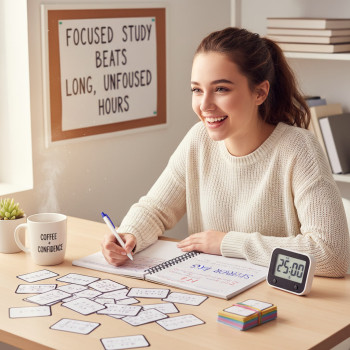Introduction: You’re Not Alone — A Practical Roadmap for Parents
Watching your teen prepare for the Digital SAT can feel like standing at the edge of two worlds: the world of their everyday life with ADHD and the world of a high-stakes exam that rewards focus, timing, and strategy. If you’re a parent, it’s natural to want to fix the stress, clear the path, and protect them from disappointment. The good news: with patience, the right information, and practical habits, you can help your teen not just survive SAT prep — but come away stronger, calmer, and more confident.

Start With Systems: Understand Accommodations and Formal Steps
The first and most important step is paperwork and planning. If your teen has a documented diagnosis of ADHD and their symptoms materially affect testing, they may qualify for College Board accommodations on the digital SAT. These accommodations can be transformational — extended time, extra breaks, screen reader or text-to-speech options, and other assistive tools are designed to level the playing field.
What parents should do first
- Talk to your school’s SSD (Services for Students with Disabilities) coordinator or your guidance counselor early. They usually initiate or submit the accommodations request to the test provider.
- Gather documentation: recent evaluations, individualized education plans (IEPs), 504 plans, or professional assessments that describe functional impacts and testing recommendations.
- Submit requests well ahead of planned test dates — approvals can take several weeks. If an upcoming test is imminent, register as a standard test taker; accommodations can sometimes be added later if approved.
- Practice with the approved accommodations. The digital SAT delivers some accommodations differently than paper tests. For example, screen readers or built-in text-to-speech might replace a human reader. Make sure your teen knows exactly how their approved tools work.
Designing a Study Routine That Respects ADHD Wiring
ADHD often comes with variable attention, hyperfocus at times, and fatigue at others. A one-size-fits-all study schedule won’t work — but a few adaptable structures will.
Principles that guide a helpful routine
- Short bursts, frequent changes. Think 25–40 minute focused sessions with 5–15 minute breaks rather than marathon studying. Use a visible timer or an app that shows progress.
- Frequent wins. Start sessions with a 2–5 minute warm-up task the teen enjoys (a quick brain teaser or a mini-review) so the brain associates starting with small wins.
- Mix active and passive learning. Alternate question practice with short instructional segments, timed drills with untimed conceptual review, and reading practice with immediate reflection.
- Predictability plus flexibility. Keep consistent study times for habit-building but allow those blocks to shift based on medication cycles, sleep, or emotional load.
Sample weekly study structure
| Day | Focus | Format | Duration |
|---|---|---|---|
| Mon | Reading (passage strategy) | Timed passages + review | 3 x 30-min sessions |
| Tue | Math (concept practice) | Untimed concept drills + video lesson | 2 x 40-min sessions |
| Wed | Practice Test (short sections) | Bluebook practice sections or official digital module | Two 45-min modules |
| Thu | Writing & Language | Targeted grammar drills | 3 x 30-min sessions |
| Fri | Skills review | Flashcards + error log review | 1 x 45-min session |
| Sat | Full practice + debrief | Practice test (with accommodations if possible) + tutor review | 2–4 hours with breaks |
| Sun | Rest & light review | Leisure reading, vocabulary in context | 30–60 minutes optional |
Make the Digital Format Work for Them
The Digital SAT is different from paper tests in useful ways for many students with ADHD: adjustable text size, built-in timers, easy navigation between questions, and integrated accessibility tools can reduce friction. But there can also be distractions (notifications, unfamiliar interfaces) and sensory overload. Practice matters.
Practical digital tips
- Install and practice on the same platform the test uses — familiarity reduces cognitive load on test day.
- Teach navigation strategies: flagging questions, using the review panel, and structured time allocation per module.
- Use permitted accessibility tools during practice so the teen builds trust in them. For instance, if they’ll have text-to-speech, do several practice sections using it so it feels natural.
Emotional Support: Small Moves That Create Big Calm
For many teens with ADHD, anxiety can be as limiting as attention itself. Your role as a parent is not to eliminate all worry, but to give them tools and signals that their feelings are valid and manageable.
Concrete ways to support emotionally
- Model calm and curiosity. Ask about their challenges and solutions rather than immediately fixing them.
- Normalize breaks and downtime — productive rest helps attention recover.
- Celebrate effort, process, and small wins rather than only scores. Note improvements in stamina, strategy use, or reduced frustration.
- Use language that separates the teen from the diagnosis: “You have ADHD” versus “ADHD is making this harder right now.” The latter externalizes the challenge and reduces shame.
Targeted Strategies for ADHD Strengths and Weaknesses
ADHD brings patterns — time blindness, distractibility, inconsistent working memory — but it also often includes strengths like creativity, rapid pattern recognition, and the ability to hyperfocus on interesting tasks. The goal is to design prep that minimizes the weaknesses and taps into strengths.
Working memory and multi-step problems
- Teach externalizing tactics: write down intermediate steps, annotate passages, or use scratch paper to offload memory demands.
- Break math problems into labeled steps: (1) What’s asked? (2) What’s given? (3) What’s next? This scaffolding converts an abstract problem into checklist items.
Time blindness and pacing
- Practice with visible timers and alarms. Use concrete time markers (e.g., “In 12 minutes we’ll be halfway through this module”).
- Teach “time-check rituals” — quick looks at the timer at fixed intervals and small micro-goals to hit between checks.
Inattention and sustaining effort
- Interrupt monotony with variety: switch question types, alternate reading with short writing, or add a tactile element like a fidget that doesn’t distract.
- Allow movement breaks — a five-minute walk or stretch can reset attention more effectively than another 20 minutes of sitting.
Tools, Resources, and the Role of Tutoring
Official practice materials are essential: practice modules, diagnostic tests, and full-length practice sessions. But how those materials are used matters more than which ones you have. For many families, personalized tutoring helps turn practice into progress.
What effective tutoring does
- Creates a personalized study plan keyed to your teen’s attention profile and test goals.
- Provides 1-on-1 guidance that adapts pacing, uses immediate feedback, and models test strategies in real time.
- Helps your teen practice with accommodations and builds habits for test day (timing, breaks, tech use).
For example, Sparkl’s personalized tutoring blends one-on-one guidance, tailored study plans, expert tutors, and AI-driven insights to help students prioritize weaknesses while building endurance and confidence. When a teen with ADHD works with an experienced tutor, the sessions can focus on attention scaffolds, active strategies, and pacing — all within a supportive, goal-oriented environment.
Practice Tests: How to Use Them Wisely
Practice tests are not just measurement tools; they are training environments. But they must be used the right way — especially for teens with ADHD.
How to make practice tests high-value
- Simulate conditions gradually. Start with short, timed modules before attempting a full test.
- Use accommodations during practice if they will be used on test day. Familiarity reduces cognitive load.
- Always debrief. Review errors together and find patterns — are mistakes careless, strategic, or knowledge-based? Tackle one pattern at a time.
- Track stamina, not just score. Note when attention drops and how long recovery takes. Build endurance across weeks rather than attempting it all at once.
Test-Day Logistics and Small Calming Rituals
Plan practical details so the teen can focus on the test itself.
- Confirm accommodations are on the admission ticket and in the test app before leaving home.
- Pack a “comfort kit”: allowed snacks, water, noise-reducing headphones (if permitted), and a small fidget. For those with extended breaks, plan exactly how to use breaks to recharge.
- Rehearse the morning routine: wake-up time, breakfast, medication schedule (if applicable), and travel buffer to the testing site or setup for the digital environment.
- Teach a short calming ritual: 3–4 slow breaths, a quick body scan, or a cue word like “steady” to reset in moments of anxiety or distraction.
Communication: How to Talk About Progress and Setbacks
Constructive communication matters. Teens can be sensitive to perceived pressure or criticism. Your tone should be partnership-focused.
Language that helps
- Ask reflective questions: “What part of that practice felt useful?” rather than “Why did you miss those questions?”
- Focus on process goals: “This week we’ll build a 30-minute streak” rather than only score goals.
- Normalize setbacks: say, “This is one practice test — it shows useful data,” and then pivot to an exact plan for the next week.
Measuring Progress: What to Track
Move beyond a single score. Track metrics that reflect skill, strategy, and endurance.
| Metric | Why it matters | How to track |
|---|---|---|
| Accuracy by question type | Shows knowledge gaps vs. attention errors | Keep an error log and tag mistakes (concept, careless, timing) |
| Stamina over time | Shows attention endurance and need for pacing strategies | Note when score drops during a test and how long recovery takes |
| Time per question | Helps with pacing and identifying time-sink questions | Use practice app analytics or simple timer logs |
| Response to accommodations | Shows whether accommodations are sufficient or need adjustment | Practice with the accommodation and note confidence, speed, and fatigue |
When to Bring in Extra Help: Tutors, Clinicians, and School Partners
If progress stalls, consider layered support. A good tutor can convert hours of practice into measurable improvement; a clinician can reassess medication or coping strategies if ADHD symptoms worsen; school SSD coordinators can help with documentation or alternate testing options. These supports should complement, not replace, your teen’s ownership of prep.
Final Thoughts: You’re Building More Than a Test Score
Helping a teen with ADHD prepare for the Digital SAT is not just about achieving a target score — it’s about teaching how to prepare for high-pressure tasks, build systems that respect neurodiversity, and grow confidence through scaffolding. As a parent you bring patience, structure, and perspective. As a team, you and your teen can lean into tools, accommodations, tailored routines, and, when helpful, personalized tutoring to make the path clearer.
Small, consistent changes — a practiced break routine, an annotated scratch-paper habit, a single targeted tutoring session each week — compound. And remember: colleges see your teen’s whole application, not one test. A supportive preparation process helps them show up at their best, both on test day and beyond.

Quick Checklist for Parents
- Start the accommodations request process early and practice with approved tools.
- Build short, varied study sessions and track stamina, not just raw scores.
- Use practice tests strategically: simulate, debrief, and adjust.
- Keep emotional support front-and-center; celebrate process wins.
- Consider personalized tutoring (1-on-1 guidance with tailored plans and AI-driven insights can accelerate focus and strategy adoption) when progress plateaus.
Resources to Keep Close
Keep your school’s SSD coordinator, your teen’s teachers, and your chosen tutor in regular contact. Coordinated support, clear documentation, and an adaptive plan will make the whole process easier and more effective.
Parting Note
This journey can be challenging, but it’s also an opportunity: to teach your teen advocacy, self-knowledge, and testing strategies that will serve them long after college admissions. With accurate information, consistent routines, and supportive guidance — including tailored tutoring when it’s right for them — your teen can approach the Digital SAT with greater calm and real competence. You’re building life skills as much as test skills — and that matters far more than any single score.















No Comments
Leave a comment Cancel